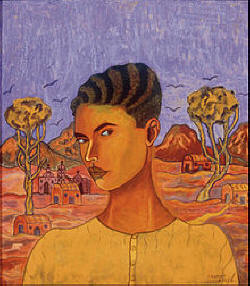

Partner Manuel Rodríguez Lozano
Queer Places:
Museo Nacional De Arte MUNAL, Calle de Tacuba 8, Centro Histórico, Centro, 06000 Ciudad de México, CDMX, Mexico
 Abraham
Ángel Card Valdés (March 7, 1905 – October 27, 1924) was a Mexican artist
known under his first names Abraham Ángel; he dropped his surnames
after his brother Adolfo expelled him from his family home when Abraham Ángel
was barely 16.
Abraham
Ángel Card Valdés (March 7, 1905 – October 27, 1924) was a Mexican artist
known under his first names Abraham Ángel; he dropped his surnames
after his brother Adolfo expelled him from his family home when Abraham Ángel
was barely 16.
Abraham Ángel was born in El Oro, State of México, being the youngest of five. His father was Lewis Edward Card Burke (originally Carthburke Beedgar), a Welsh miner and adventurer, who travelled continuously throughout the country in search of fortune in gold and silver mines. His mother, Francisca Valdez, was from Sinaloa, México. At just 14, she left home to follow Lewis to El Oro, and form a family with him. Lewis, a gambler and womanizer, left a few years later, rarely seeing the family again.
The older brother, Adolfo, became head of the family, which left in search of a better life to Puebla, Mexico, where Abraham Ángel spent his childhood. At age 11 he moved to Mexico City with his mother, his sister Amelia and his older brother Adolfo, who remained in charge. Abraham Ángel was raised in a strict Protestant environment, the religion professed by his father, which had been energetically adopted by his brother Adolfo.
At age 16, Abraham Ángel decided to attend art and painting studies at Escuela Nacional de Bellas Artes (also known as Academia de San Carlos), a decision met with absolute opposition from his brother Adolfo. Abraham Ángel refused to comply, so he ended up being expelled from his home, to the astonishment and sadness of his mother and sister. It was 1921, and Abraham Ángel had already met Manuel Rodríguez Lozano, his tutor, with whom he had an intense homosexual affair, and who gave lessons in drawing based on the methods of Adolfo Best Maugard.[1] In that difficult moment Abraham Ángel decided to drop his surnames and moved to his lover’s home.
Museo Nacional de Arte, Mexico City, Mexico
Prior to the 1940s, many same-sex-attracted men found it easier to cohabit abroad. For painters Alfonso Michel and Agustín Lazo Adalid, cohabitation appears to have been too strong a statement to make in Mexico City. Michel lived with a Jewish boyfriend in San Francisco in 1919–20, before reproducing a similar living arrangement with a Norwegian businessman – Thorlaif Imerslund – in Berlin and Nice circa 1922–24, and then with Agustın Lazo in Paris in 1924–26. Similarly, gay Spanish Republican exile Luis Cernuda, who regularly visited Mexico City during the late 1940s and early 1950s before settling there permanently, found it difficult to cohabit with his boyfriend, Salvador Alighieri, a twenty-year old Italo-Mexican bodybuilder. The inspiration for Cernuda’s Poemas para un cuerpo, Aligheri and Cernuda regularly met at the Hotel Geneve until 1955, when Aligheri disappeared and Cernuda moved in with Spanish writers Manuel Altolaguirre and Concha Mendez. For Manuel Rodríguez Lozano, already ostracised for his divorce from Carmen Mondragon in 1921, it was relatively easy to live with his youthful lover Abraham Ángel, as the age difference (and his previous marriage) gave them an alibi. Tragically, the men’s relationship ended when Manuel’s infidelities pushed Angel to a drug overdose suicide.
When Lozano chose another young artist, Julio Castellanos, as his protégé, he abandoned Abraham Ángel. Humiliated and depressed, he was found dead from an accidental cocaine overdose[2] on October 27, 1924.
Raoul Fournier was a friend of Manuel Rodriguez Lozano, Abraham Ángel, Julio Castellanos, the friendship with Abraham Ángel was fruitful when the painter illustrated the doctor's thesis: «The pathophysiology of nephritis. Current state of play. Physician's Conduct." Raoul maintained a very short-lived relationship with Manuel Rodríguez Lozano, which resulted in a strong friendship, which can be seen at the moment when Raoul lifts the death certificate of Abraham Angel, something imprecise because of the belief that the young painter had died of a heart attack, hiding what was later known: Abraham Ángel had committed suicide in the workshop of Manuel Rodriguez Lozano.
His scarce works, numbering around 30 known paintings, are highly appreciated and valued by museums and art collectors.
My published books: